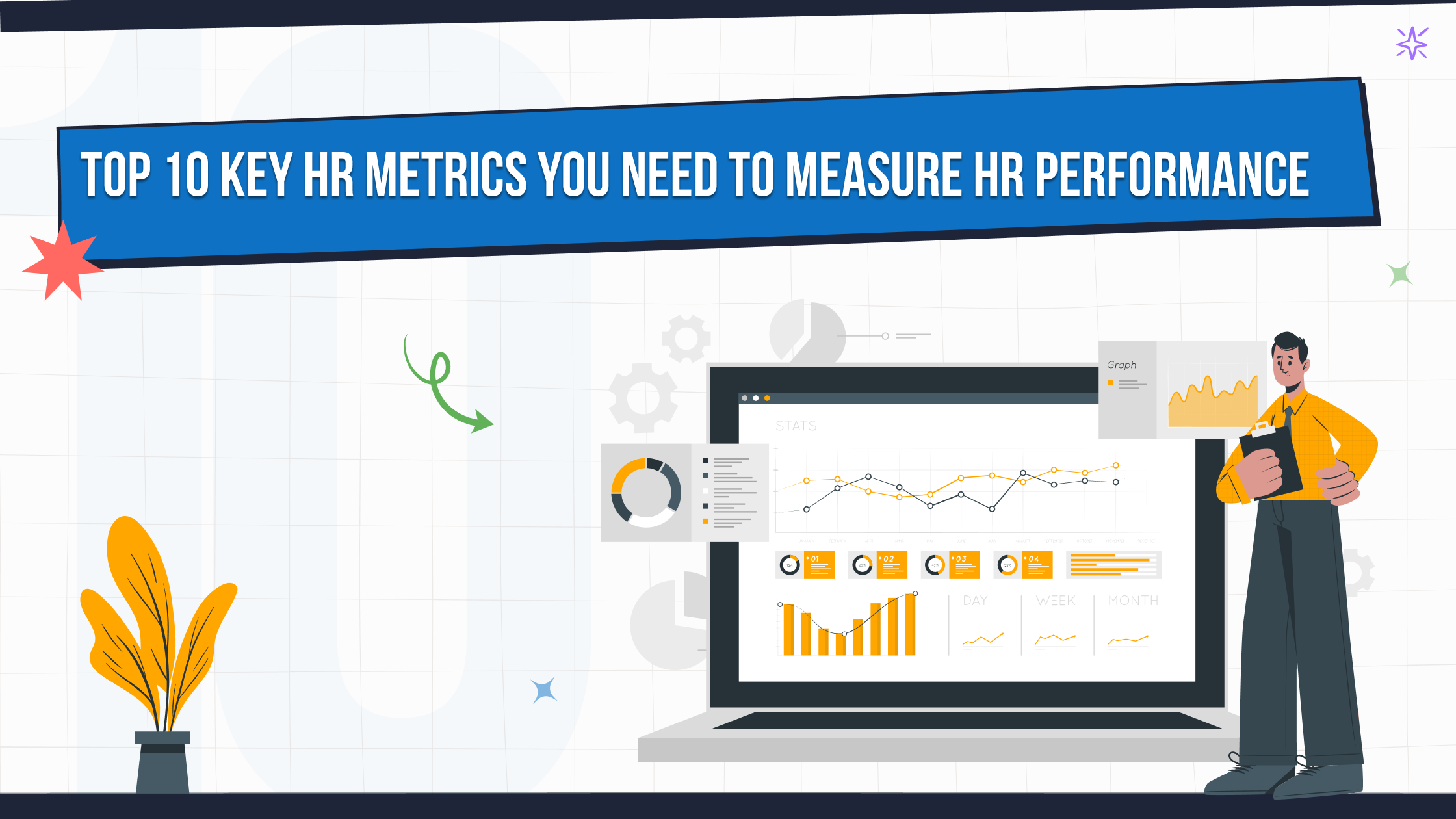UBS App is now Superworks

Strategic HR is a practice that is gaining popularity among businesses around the world. Possibly one of the biggest indicators of that growing popularity is the increased focus on HR metrics as a prime component of an organization’s overall business strategy.
To make sure they can do their jobs effectively, it has become essential to monitor their effectiveness. Companies have become aware of how simple it is to measure important HR KPIs as HRMS usage grows. The management can enhance the HR division using the information gathered in this way.
Let’s examine 10 HR performance metrics to gauge HR performance after understanding what they are and their significance.
What are HR metrics, though? How can an organization go about raising its data analysis game to match these rising expectations if CEOs are starting to appreciate them more? You need to have a solid understanding of the fundamentals of HR metrics and which ones, in particular, you should start tracking right away if you want to have a significant impact on your firm.
HR Metrics also known as HR Performance Metrics, are the measurements that help organizations track the key areas in their HR data. Basically, they are the HR performance indicators that track an organization’s human capital and measure how effective their human resource initiatives are on the success of the business.

The HR metrics can be categorized into three areas, each with its own set of key indicators associated with those areas:
Since the HR metrics help the organizations understand the efficiency of the HR teams, it helps in setting the baseline for tracking and measuring any improvements down the line. Improving the strategies of the HR Department will help you with lots of benefits for your business, as they are the ones who manage the business.
Your employees will be more engaged with your business for a long time if your HR department is better. Additionally, it would lead to more effective workers, which is good for your business over the long run. HR performance indicators are therefore crucial for any organization.
Cost per Hire metrics also known as CPH shows how much it costs to hire new employees. This also serves as an indicator of the efficiency of the recruitment process.
Calculating cost per hire can take some time. Before The Society of Human Resource Management and the American National Standards Institute came to an agreement on a standard formula, there used to be a significant amount of diversity in how businesses measured this HR performance indicator.
CPH can be calculated by multiplying internal and external expenses of recruiting by the total number of hires. Both the costs and the number of hiring will reflect the chosen measurement period, which could be monthly or yearly.
This is undeniably one of the most important HR metrics to determine the hiring success of the company.
The early turnover metric lets the company know whether there is a mismatch between the employee and the company or between the employee and his/her position. Early turnover is also very expensive. It takes almost between 6 to 12 months before the employees have fully reached the optimum productivity level.
Basically early employee turnover is the percentage of the total number of employees that leave the company within the joining year. It is also called the new-hire turnover. However, suppose the employee is leaving the company within the joining year, it is a loss for the company as the company is investing time and effort in training the employee.
Additionally, they will have to find a replacement for the position which will require them to repeat the complete cycle costing them so much.

The “time to hire” is a very important recruitment metric. This counts the days that pass between a job applicant submitting an application and accepting a job offer. Time to hire provides information on the effectiveness of recruiting and the candidate experience.
Recruitment efficiency gauges how quickly HR handles an applicant through evaluation, interview, and role acceptance. When it takes your company a while to hire someone, it shows how ineffective your processes are. A lengthy hiring process reflects poorly on the candidate’s experience. If the hiring process is drawn out, candidates may give up. Wouldn’t you rather start a new job in two weeks than two months? The most qualified applicants are in high demand and do not need to wait.
Not to be confused with time to fill, is time to employ. This indicator often counts the number of days that pass between a job requisition’s acceptance and the applicant accepting the job offer.
This HR performance metric shows the performance of an organization as a whole. The “revenue per employee” is the metric that shows the quality of the employee hired. Since revenue is the indicator of performance, it helps the organizations understand whether the employees are performing well. To calculate the revenue per employee, you need to calculate the overall revenue of a company for a specific period of time and divide it by the total number of employees working in the company during that period.
With great engagement comes great productivity. Engagement might be the most ‘soft’ HR outcome. Employees who like their job and are satisfied with their company are likely to be more engaged, even if the work environment is quite challenging and the work pressure is high.
Engaged employees tend to perform better and are more likely to perceive challenges as interesting and positive. Moreover, team engagement is an important metric for the success of the team manager.
The “HR Efficiency Ratio” is the indicator that is used to understand the ratio of the HR professionals to the employees working in that organization. Putting it simply, it is the number of employees working in an organization per HR professional. If we are looking for an ideal scenario, a smaller number of HR professionals should be able to manage a larger number of employees.
This metric shows the efficiency of an HR. Suppose a single HR can manage a larger number of employees, it shows that the HR department is equipped with robust employee management software and the fact that the HR is performing beautifully.
The metric “Employee Turnover Rate” or “Total Turnover Rate” is used to gauge the frequency with which workers leave the organization for a certain period of time. It is typically expressed as a percentage, which can be computed by multiplying the number of employees leaving by the average number of workers over the relevant period to get the % figure.
Understanding which departments are working effectively with their personnel and which require restructuring to ensure that employees stay with the company for a longer period of time depends on the employee turnover rate. It is also important when hiring talent since, if you frequently lose staff, you may need a fresh recruitment strategy.
Just like turnover, absenteeism is also a strong indicator of employee dissatisfaction and a predictor of turnover. The Absenteeism rate or absenteeism percentage is the average percentage of the days an employee is absent to the total working days in a specific period. This metric does not include the planned time-offs that have been approved beforehand.
You can take the appropriate steps to lessen the percentage if it has been high for a while. On the other hand, if a certain department has a high absenteeism rate, you should speak with the team members to figure out what’s happening. A higher absence rate is typically a sign of deeper issues that, if not addressed, could lead to a higher employee turnover rate.

Since there isn’t a single industry standard for measuring employee performance, numerous distinct approaches are used in the “Employee Performance” statistic. Peer reviews, supervisor evaluations, self-evaluations, or even a combination of all three are frequently used to quantify it.
Additionally, businesses have begun using the “nine-box matrix” to gauge employee performance. Based on their current performance and room for improvement, the employees are organized into a 3×3 matrix. Organizing the workforce into categories makes it easier to plan focused training and improvement techniques to guarantee adequate growth.
Measuring the Proficiency of HR Software is complex as it depends on several factors. Companies usually calculate the number of employees using the HRMS and divide it by the total number of employees in the organization. This helps the company understand the HR software employee participation rate. This metric gives a good idea of HR Software proficiency.
If the HR Software proficiency is low, you need to check the reason and make the necessary changes. Using HRMS for necessary HR-related activities reduces HR’s workload and helps you focus on employee engagement.
You can see that there are numerous important HR metrics. The value of HR metrics lies in their capacity to help you reach fact-based, data-driven judgments. All metrics offer information on the workforce and HR, albeit some are simpler to apply than others. Making judgments that are supported by evidence and have a positive impact requires combining these insights. The appropriate HR performance indicators for your firm depend on a number of variables, including the size of the business and the available funding.
Employee Performance and Productivity are some of the metrics that can be measured easily with the help of efficient HRMS software. If you are looking for one, connect with UBS.
The 4 levels of HR metrics are as follows: Operational Reporting, Advanced Reporting, Strategic analytics, and Predictive Analytics. Read the blog to know more about the HR performance metrics.
For every organization, HR metrics may vary according to the type and size of business. However, the above blog describes the top 10 HR metrics that every organization must measure.
The first are data points, and the second are measurements. Metrics only quantify the difference between numbers and offer nothing about a reason. The quantification of people drivers on business results is known as HR analytics, also known as people analytics.
We are here to help you find a solution that suits your business need.
Get a visual representation of how we work!
Schedule DemoOur sales expert is just one call away to meet your needs.
Get In TouchHave a question?
Chat with Us